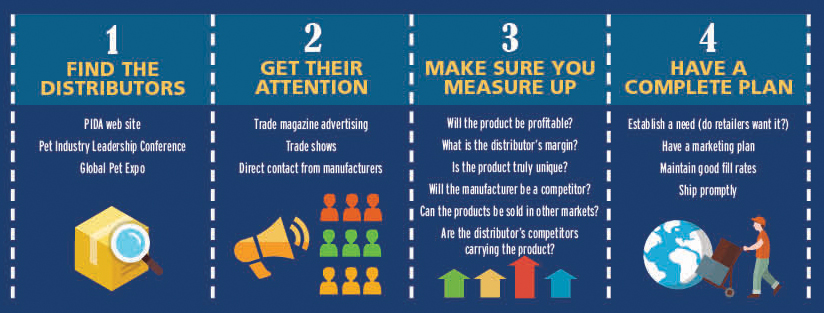The Power of Distribution is never more evident than when you don’t have it. That’s why establishing a distribution network is often the first order of business among manufacturers launching new products, product lines or line extensions in the pet industry. Creating this network effectively boils down to these four steps:
The best source of information on pet product distributors is the Pet Industry Distributors Association. PIDA’s online distributor locator allows you to find distributors by service area, location and, in some cases, specialty.
In addition to its web site, PIDA offers opportunities for face-to-face contact between distributors and their manufacturer trading partners. The Pet Industry Leadership Conference, co-sponsored by PIDA and the American Pet Products Association and held at the beginning of each year, offers several networking and educational opportunities. Included among these is a series of executive conferences where distributors meet one-on-one with their suppliers. PIDA and APPA also co-sponsor Global Pet Expo, held annually in March.
Distributors in the pet industry typically rely on three sources for information on new products.
If you’re not already familiar with advertising and exhibiting opportunities in the pet industry, you can find links to the organizations that provide them at www.pida.org.
For direct contact, many manufacturers use e-mail to make initial contact with distributors. They follow up with relevant product samples and a request for a face-to-face meeting.
There is a misconception that pet product distributors are not looking for new products. Nothing could be further from the truth. New items fuel growth for every segment of the industry — including distributors. They are always looking for products that grow their business.
 Click on image above to enlarge.
Click on image above to enlarge.
Pet product distributors have rigorous standards for taking on new products. The typical distributor stocks more than 12,000 skus, so new to you is not necessarily new to them. When asked to take on something new, the first consideration is whether the product or line will be profitable. Here are some questions that factor into the profitability analysis.
What is the distributor’s margin? Distributors add value for manufacturers in several areas. They streamline the distribution process by allowing manufacturers to ship in larger quantities to fewer locations. They improve cash flow by allowing manufacturers to work with fewer, more reliable accounts. They have built relationships with retailers that can help manufacturers market their products. This value has cost. Distributors must cover those costs and make a fair profit in exchange for their services.
Is the product or line truly unique? “Me too” and “new to you” knock-offs and line extensions typically do not grow a distributor’s business. They simply shift dollars from one manufacturer to another. Distributors are looking for products that will increase sales both for them and their customers.
Are the distributor’s competitors carrying the product? Like every business, distributors are looking for a competitive edge. If a distributor perceives that a product is over-distributed in their area, the product becomes less appealing.
Will the manufacturer be a competitor? Distributors are looking for partners rather than competitors. Most distributors welcome manufacturer contact with retailers as it adds value to the marketing process. However, manufacturers that sell directly to retail accounts in a distributor’s area are competing directly with that distributor.
Can the product be sold into other markets serviced by the distributor? Many pet product distributors also sell to the veterinary or agricultural markets. If a product has appeal in those markets as well, it has increased profit potential.
Equally important as competitive pricing is a complete marketing plan that reaches down to the retail level. Successful new lines must be something retailers want to buy. That interest starts with the manufacturer and a complete marketing plan is essential.
Service is another important factor impacting successful distribution. Maintaining good fill rates and shipping products promptly allows the distributor to keep inventory levels lower while facilitating more desirable inventory turns, both of which add dollars to the distributor’s bottom line.
The bottom line on establishing effective distribution is looking at things from the distributor’s perspective. Get to know distributor issues and how distributors function. Communicate to the distributor how your product line enhances their business. Demonstrate your ability to market your products effectively. Finally, help make the distribution channel efficient through proper packaging, reliable shipping and good fill rates. This will drive cost out of the channel, get your products to market faster and put the Power of Distribution to work for you.